
You only get one chance to make a last impression.
Yes, you read that right. We all know first impressions matter, but your follow-through is what often seals the deal.
Imagine an email reader who notices your eye-catching email subject line and opens your message. The intro hooks them, and the main message is exactly what they need to hear. Finally, they get to your call-to-action (CTA) at the bottom of the message. This is when the person decides to take the next step or not.
Now, think about what they see at the bottom of their email window. Does it look engaging and professional, like you’d expect from a legitimate company’s marketing?
Email footers provide credibility. When a reader is about to take action, a professionally-designed footer says, “It’s okay. We know our stuff.” Plus, email footers keep you in line with the rules of what you can and can’t send by email. They pack a lot into a small amount of space and are easier to create than you might think.
It’s okay if you’re not familiar with email footer best practices! Once you finish reading this article, you’ll know what needs to go in one and what you can do to make it on-brand. But first, let’s cover the basics.
The fundamentals of email footers
Email footers aren’t new. Even when “snail” mail was the only option, companies would print their addresses and phone numbers at the bottom of a letter.
That’s really all an email footer is. It’s information that boosts your credibility without cluttering your main message.
If you’re learning how to write a newsletter email or marketing message — or you need a refresher on footers — here are the basics.
What is the footer text in the email?
An email footer is the last block of content in a business email. It includes your business’s address, an unsubscribe link, and any other last-minute links or information you want the reader to have. Many companies also add social media icons, legal disclaimers, and additional contact details.
Some footer text is intentionally neutral, as in this example:

Marketers might choose this style of footer to emphasize a minimalist brand aesthetic. It’s also effective at shifting focus back to the email body.
Other footers are bright and colorful and have brand logos and special messages to readers. Both approaches can work well as long as you meet the legal requirements.
What are the legal requirements for email footers?
Email footers reinforce the professionalism of your email, both aesthetically and legally. We’ll talk about aesthetics later. First, you’ll need to understand the legal requirements for email footers.
If you send marketing messages to U.S. customers, you must abide by the U.S. Federal Trade Commission’s CAN-SPAM Act. A footer lets you fulfill two key requirements of the Act, which are:
- Providing your physical mailing address within the email
- Offering an easy-to-find option to unsubscribe or change email preferences
If your email goes to other countries, or there’s a chance it might, other rules will apply. Keep reading to learn more about the General Data Protection Regulation (GDPR) that applies to European residents.
How do I insert a footer in an email?
It’s easy to forget a footer because you mistake it for a signature.
A signature is your email sign-off. If you don’t have an established signature for your business, including your marketing emails, put “email signature branding” on your to-do list.
Signatures are part of your email’s body copy. You can type them in or have yours pre-set in your newsletter email template. If you’ve already covered that, you earn a gold star.
Next up is the footer.
Most templates have a footer section. The above example comes from Constant Contact’s templates and looks like this:
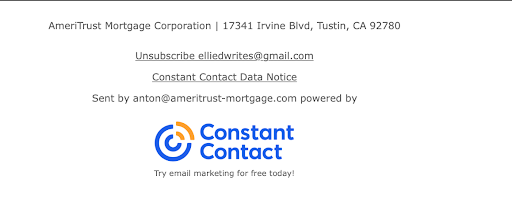
Another option is to custom-build or edit your footer. If you plan to go this route, look for an HTML email template. These templates use HyperText Markup Language (HTML), the standard programming language for building web pages.
Don’t worry! If you don’t know HTML, a Constant Contact Design Specialist can work with you.
Designing your email footer
Now comes the fun part — creating an email footer design for your company.
How do I make a good email footer?
A good email footer should be simple and functional. Too much clutter detracts from the main message and can confuse the reader. You don’t want someone clicking away when they would have engaged!
You can still add brand colors and key information like a disclaimer or mission statement, but be selective. Before adding anything “extra,” ask yourself if it’s necessary. For example, discount flight club Going adds a disclaimer about an upcoming promotion:
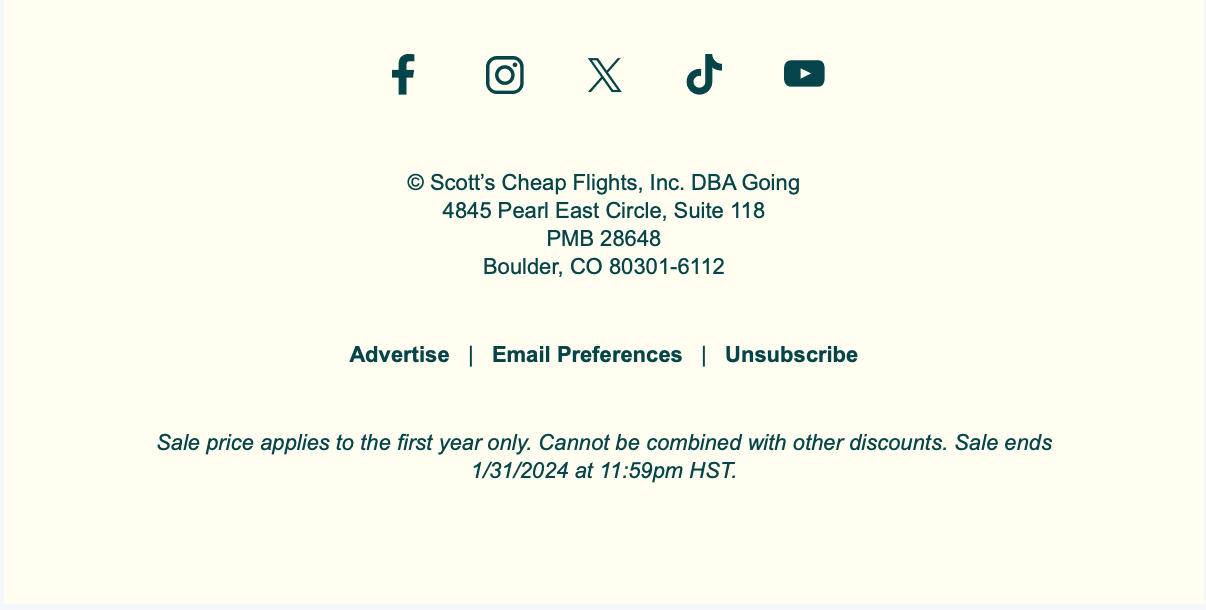
This footer has all the information you need, plus plenty of white space. When in doubt, add a blank line between every paragraph. Keep paragraphs below three lines whenever possible.
The footer includes your “fine print,” so keep it professional. Remember, your goal is to convey information without distracting the reader.
Finally, be sure to use a mobile-responsive email footer template. Statistics show more than a third of email opens happen on iPhones, and those aren’t the only smartphones on the market. If your footer looks great on mobile, you’ll look more professional.
If you have a mobile-responsive email template from Constant Contact, you’re all set! Spoiler: Every Constant Contact email template checks this box.
What other features can email footers have?
Once you cover the basics of your footer, you can start adding some extra functionality. This part is optional but adds polish and extra marketing power.
For example, many brands add social media icons to their email footers. Social icons are aesthetically simple yet recognizable to social-savvy readers. They don’t need explainer text, so you can drop one in without cluttering your footer.
You can also use email footers for important industry disclaimers, which are key for regulated industries like law and finance. Glance over this example from Capital One:
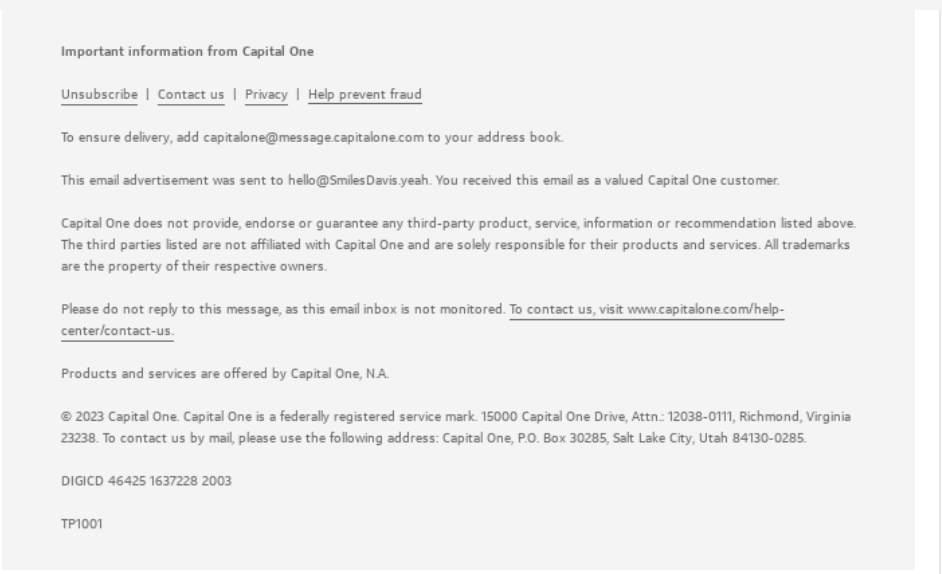
Notice that Capital One uses short paragraphs and plenty of white space to make this text-heavy footer approachable.
Essential elements of an email footer
By now, we’ve covered what email footers should look like as a whole. You’ve seen how basic is best and what little additions you can make. Now, let’s identify the content you need for legal reasons.
The footer of the email notice
If someone asks you to add a “footer of the email notice,” don’t worry — it means the email marketing legal requirements you’ve already heard about.
The most important is the unsubscribe option, which the CAN-SPAM Act and GDPR both require for all marketing emails. As long as unsubscribing is an option, you can also provide subscribers with the opportunity to change their preferences. Constant Contact’s templates include this option as “Update Profile” by default, as you’ll see in the above example.
Email marketing laws also require you to add your business’s physical address. Other contact information, such as email and phone number, isn’t required, but some marketers add these details. It’s a courtesy to readers and shows that you welcome communication.
Compliance and security disclaimers
Consumers are becoming more suspicious of letting businesses have their data. In fact, two-thirds of Americans — 67% say they don’t know what companies do with their data. Worse, 73% believe they have little to no control over the process.
Adding a privacy disclaimer can earn customer trust. Plus, if there’s any chance you might market to European residents, it’s a requirement under the GDPR.
Here’s a great example of how a marketing email discloses where it received the consumer’s data:
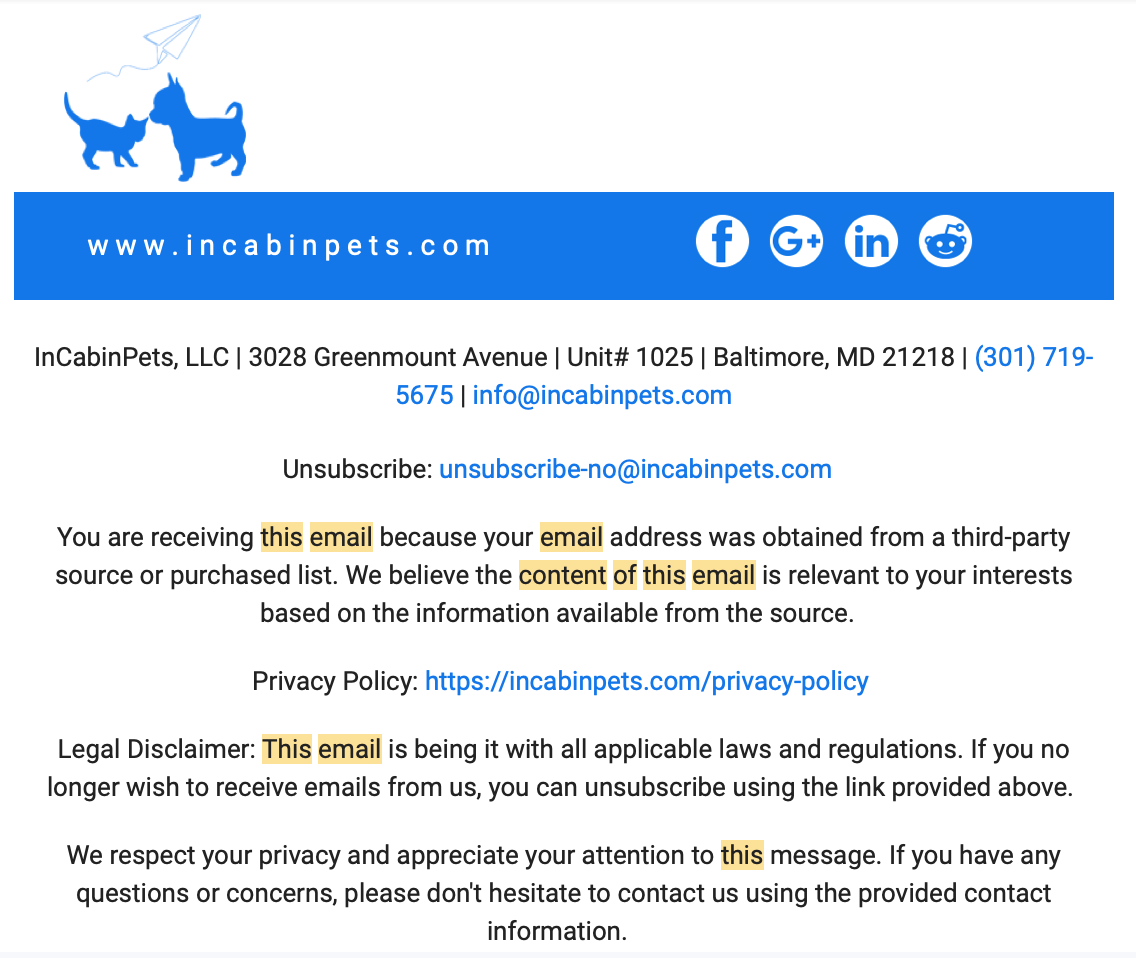
Again, each paragraph is short, and the footer uses links to further break up text.
Advanced email footer features
Now that we’ve covered legal details, we can talk about “extras.” For example, some businesses use email footers to emphasize brand values and missions.
Consider that 82% of consumers want to buy from brands that share their values. A sentence or two about what drives your business can go a long way.
Sustainability is a particularly popular value with today’s customers. According to recent research, 46% of consumers bought at least one sustainable product within a month. Nodding to “green” values can be as simple as:
“Your product will arrive in biodegradable packaging. Click here to learn more.”
or:
“Join us in saving paper. Think before you print!”
Call-to-action buttons
Subtle encouragement works, but you can also ask directly. Footers are ideal opportunities for a second call-to-action in emails, as in this example from Book Riot:
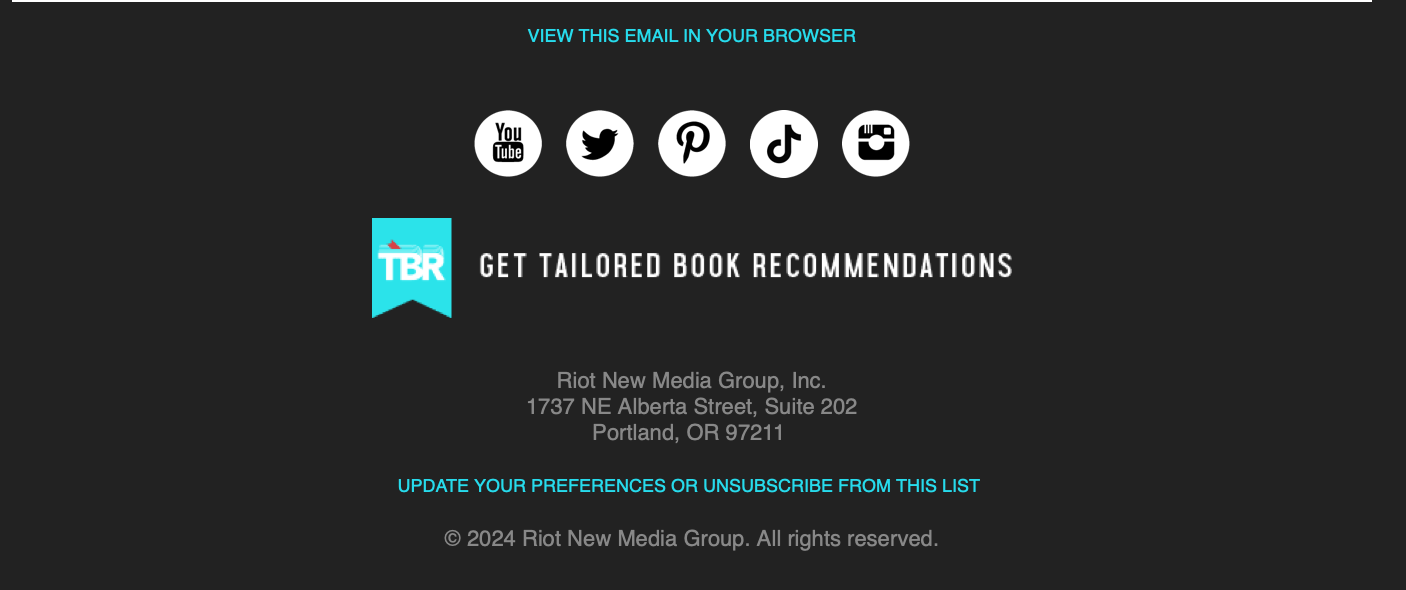
Notice the blue and bright white on the black background, a subtle touch of Book Riot branding. It draws the eye to the action-focused links, including the recommendation signup.
The footer of the email link
A footer link is any clickable link you add to your email footer. Social icons and CTAs are only two of many examples. You can also include links to:
- Review pages and other social proof
- Referral incentive programs
- Privacy and other policies
- Customer account pages
Also, are you working on how to measure email marketing success? Consider making some of these links trackable for email analytics. Analytics give you important data on what kinds of messaging your readers respond to.
Customizing your email footer
The examples you’ve seen so far are only some of the customizations you can make to your footer. You can add almost any feature, such as this star-rating widget from Delta Air Lines:
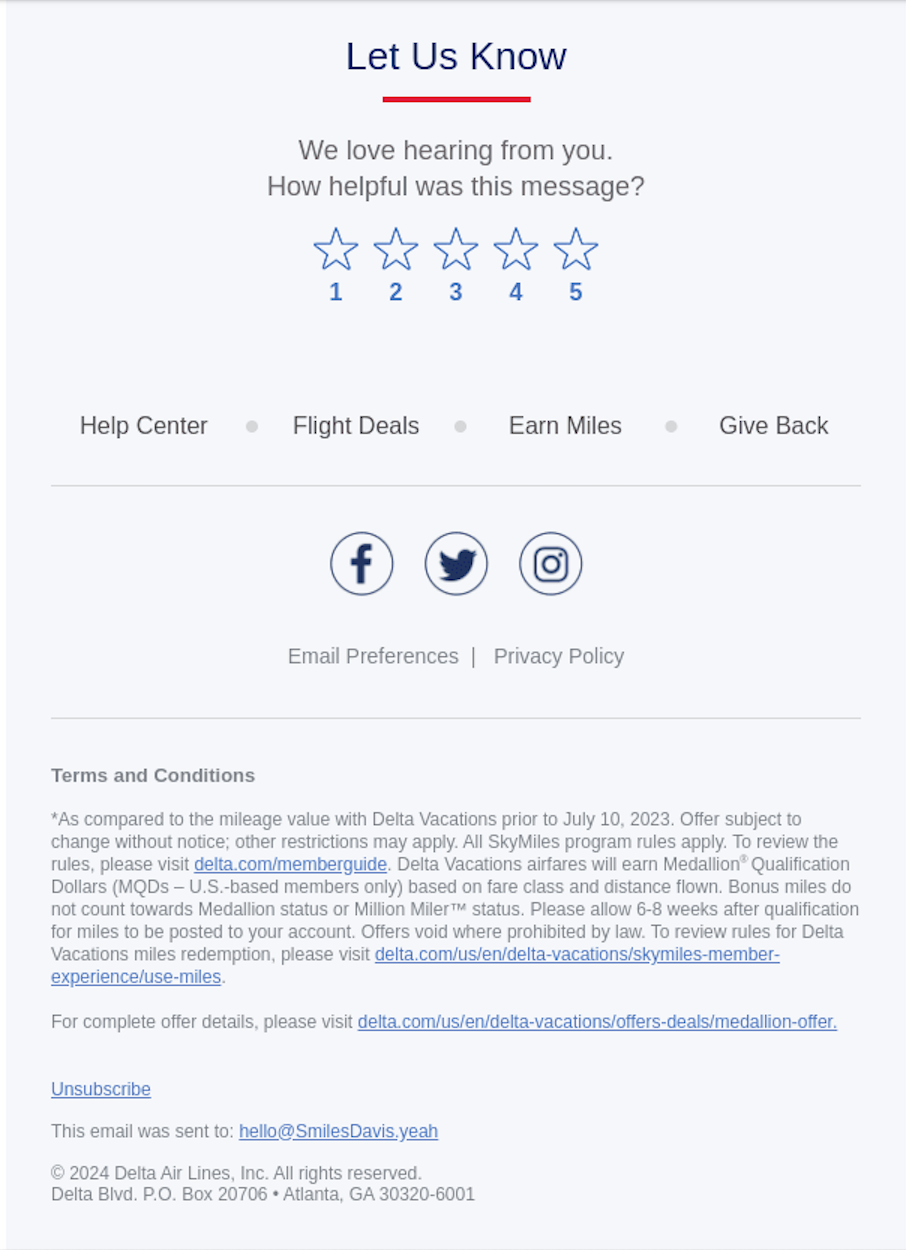
Here’s one that combines consumer engagement with a focus on brand values:
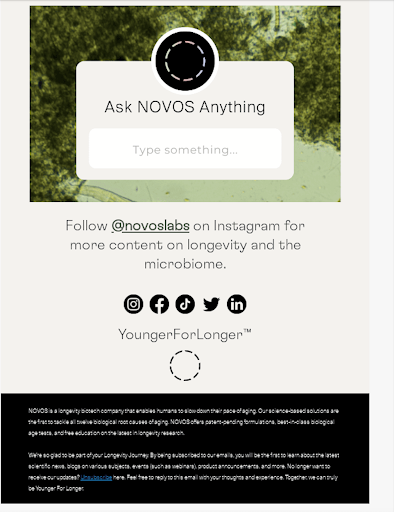
This is an excellent example of a footer that emphasizes brand values and personality. The graphics, color scheme, and voice suggest gentle care and natural health. Those who want to learn more can read the text in the black box, where Novo summarizes its mission and purpose.
These customizations boost brand awareness and strengthen customer relationships. That’s a lot to accomplish in a relatively small amount of space. After all, the best length for an email newsletter is “no longer than necessary.”
A few technical tips
These creative email footers make great inspiration. Now you’re probably wondering how to create something that effective — something other marketers will include in an article about the best email footers.
Your best bet is to use an email marketing service like Constant Contact and make small changes until it looks just right. Apply these tips to get started:
- Use templates for free email footers and customize them with your brand colors and fonts.
- Follow email marketing best practices, including branded designs and the all-important mobile optimization.
- Use effective copywriting techniques to make the text clear and engaging.
- Add user-friendly drop-downs. If you have elements that won’t fit in a brief footer, consider adding a drop-down menu to make it less overwhelming.
If you’re new to customizing email footers, don’t worry! The process is simple with Constant Contact. Step one is to look over available email templates. Choose one that seems right for your brand. Remember, you can change the colors and images as you go. Next, explore the footer template. Choose your wording and determine if you want to add any special elements.
Crafting email footers that get results
Now you understand why well-designed email footers are the heavy lifters of digital marketing. They cover your back legally while reinforcing your brand and reminding customers why they’re interested. They might even give people another chance to take action.
You also know how to find the help you need in designing your email footer. Constant Contact’s template library has everything you need to get started.
All that’s left is to decide what you want to include in your footer. Make a list starting with the requirements, unsubscribe buttons, and your address. The rest is up to you, so have fun with it!




